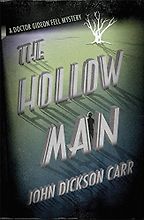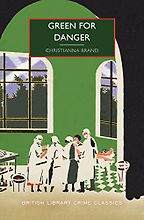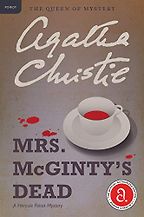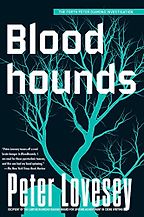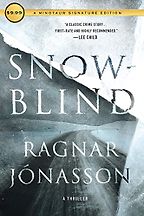Before we get to the books you’ve recommended, tell me about locked-room mysteries. What are they?
The locked-room mystery is a sub-genre of the puzzle mystery – the classic, vintage-style whodunit, where the emphasis is on the unravelling of a puzzle. Typically, the question in these mysteries is, ‘Who is the assailant that has committed the crime?’ In a locked-room mystery, there’s an added layer of bewilderment because the crime itself appears to have been physically impossible. The question becomes not only who has committed the crime, but also how was the crime committed?
This type of mystery is by its nature very complex and sophisticated in its structure, and there’s a real emphasis on the intellectual challenge that it presents to the reader. This type of mystery was particularly prominent during the so-called ‘Golden Age’ of detective fiction, between the World Wars, when writers like Agatha Christie, Dorothy L. Sayers, and Margery Allingham etc. were at the peak of their popularity.
My personal favourite of all the locked-room mystery authors is John Dickson Carr. He was the most innovative and the most prolific within that genre. He was the one who came up with the most ingenious, varied, and colourful solutions to incredibly complex problems.
Why do you think you, personally, fell in love with the locked room genre?
I am drawn to stage magic and illusion. To me, there is a considerable amount of crossover between stage magic, stage illusion, and the murder mystery. I often talk about how the mystery writer is effectively a performer, an illusionist, who is guiding an audience’s attention in the same way that a professional conjuror does.
I, personally, have a fascination with understanding how tricks are worked. I love to discover the secret gimmicks and tricks of the trade that are used by magicians. I find that the principles of stage magic are readily applicable to the murder mystery. The locked-room mystery and the impossible crime story is the point at which mystery and magic are at their closest, I think.
Let’s go through the books you’re recommended. You mentioned John Dickson Carr and the first book you’ve chosen is by him, The Hollow Man. This was published in 1935 and has some echoes of Dracula. Tell me more.
The Hollow Man is not only my favourite Carr novel, I think it’s my favourite mystery novel overall. It’s a perfect mystery, a perfect puzzle, and it’s a wonderful balance of meticulous plotting and a sense of the Gothic, the fantastic and the almost surreal, at which Carr was particularly brilliant.
The novel begins with Professor Charles Grimaud in a London tavern. He is visited by a mysterious and sinister figure – an illusionist who goes by the name of Pierre Fley. His life is threatened by this illusionist, and that is the event that kickstarts the plot. The impossibility is perfectly handled and ingeniously constructed.
What happens is an eerie, almost phantom-like figure wearing a face mask appears at Grimaud’s house and visits him in his study. A gunshot is heard. When the other residents of the building all flock to investigate, Grimaud is found shot dead in his study, and the mysterious figure, the Hollow Man of the title, has vanished without trace.
That’s the premise and it’s irresistible to someone like me because it’s got illusion, all manner of psychological trickery, but also this genuine sense of eeriness and menace to it. I don’t think Golden Age detective fiction receives the recognition it deserves for its engagement with the Gothic and its employment of Gothic tropes in its execution.
It’s Carr at his very best, and it also features his most popular detective, Dr. Gideon Fell. In The Hollow Man, Gideon Fell gives what is now known as his ‘locked room lecture,’ which is a fascinating section of the book where Gideon Fell effectively steps out of the narrative and his role as a fictional character and addresses the reader directly. He then runs through a string of ingenious methods by which a locked-room mystery can be created.
It’s all in service to the overarching mystery of The Hollow Man, but it’s also a kind of academic, scholarly study of the sub-genre as a whole and the methods that so many writers before him had used. Dickson Carr is effectively showboating his mastery of the genre while, at the same time, reinforcing the seeming impossibility of the mystery in The Hollow Man. The ‘locked room lecture’ serves multiple functions within the story, but it has also been published in its own right as an article or almost academic piece on the locked-room mystery. I find that particularly fascinating and useful. It’s something I refer back to, aside from the brilliance of the novel itself.
If somebody really likes this book, is it worth reading all the Gideon Fell books? Because he’s not as famous as Hercule Poirot, say.
Most definitely, yes! John Dickson Carr was easily the match of Agatha Christie, in my opinion. Nobody wrote murder mysteries like he did. Agatha Christie was a superb plotter as well, but Carr will always be my favourite. The Gideon Fell series is long-running, and there are many novels to dive into, but the quality is really startling. I think you could start anywhere, but The Hollow Man remains my favourite.
Let’s go on to Green for Danger, by Christianna Brand, which was published in 1944. I love reading novels written in the past, that historical element. This one takes you back to England during World War II.
This is another Golden Age mystery. As you say, it’s 1944, so it’s the height of the Second World War and it’s set in an English country field hospital. It’s fairly unique in that respect: it’s one of the only mystery novels I can think of that features that particular setting.
Christianna Brand was a superb Golden Age author. Hers is a name that deserves to be mentioned alongside Agatha Christie, Dorothy Sayers, Margery Allingham, and Ngaio Marsh. Unfortunately, she wasn’t as prolific as those authors. She wrote only a handful of mysteries, but Green for Danger represents her at her very best.
It’s not a locked-room mystery. It doesn’t feature a physical impossibility, but it does feature a perfect, closed circle of suspects. This is set up from the very first page of the novel. We begin with a postman doing his rounds. What Christianna Brand does, which is so audacious, is she itemises the handful of letters that are in his bag, which are the correspondence of our key players in the mystery – the doctors and nurses at the field hospital.
She then boldly states that one of these people is a murderer, so we know that from the handful of six or so characters to whom we’ve been introduced at that point, one of them is the murderer. It flies in the face of that Golden Age mystery cliché of having the least likely suspect – somebody who has played a minor role in the narrative – suddenly taking on new significance. We know from the beginning that our culprit is one of these people. At the same time, she’s defying us to work out which one it is. To me, that epitomises the intellectual challenge that I love so much.
It was also made into a great film in 1946, with Alastair Sim as the detective. That’s also well worth seeking out.
Let’s go to Agatha Christie now and Mrs. McGinty’s Dead, from 1952. Why did you pick this particular mystery?
There are many Agatha Christie novels that I could have picked. She is the most popular mystery writer/crime novelist of all time. There is a reason for that. Not only was she great at plotting, but she had a wonderfully readable style that remains accessible today. Even if the period in which they were written is long gone, the stories have that timelessness to them.
The reason I picked Mrs. McGinty’s Dead is because it’s a personal favourite of mine. Poirot is my favourite of her fictional detectives, and the setup to this one is so good. What we have is Poirot called in by his friend Superintendent Spence to look into the case of a young man called James Bentley, who is accused of murdering his housekeeper, the titular Mrs. McGinty. Bentley is condemned to be executed, but Spence is not convinced of the man’s guilt, and so Poirot is summoned to this small village to try and pick apart the mystery and the circumstances that led to Mrs. McGinty’s death.
The really irresistible gimmick that I absolutely love is the early revelation that Poirot makes when he discovers that Mrs. McGinty, in the days before her death, had clipped a newspaper article in which three mysterious women are discussed. These three women were involved in three separate murder cases and their fates are a mystery. Nobody knows what has become of these women.
Mrs. McGinty has written a letter to a newspaper indicating that she knew one of the women. That is the only clue that Poirot has to go on. It becomes a question of looking at these three murder cases that took place in the past and trying to determine which of the three women Mrs. McGinty knew, what the significance of that is, and how it led to her murder. Was one of these women the murderer? Or is it simply a red herring? Also, which of the three murder cases is it that Mrs. McGinty was involved with? It’s a fascinating puzzle with a perfect setup.
It also features Ariadne Oliver, who was Agatha Christie’s author surrogate in her novels. Christie put a lot of herself into the characterisation of Ariadne Oliver, and it’s very nice to see Mrs. Oliver and Poirot together on the page. They both have an excellent part to play in the mystery. To me, it’s just the quintessential Agatha Christie.
So it’s more of a puzzle than a locked-room mystery?
Yes. It’s a village mystery which Agatha Christie typically reserved for Miss Marple rather than Poirot. But what we have is an incredibly complex puzzle, which Poirot deciphers brilliantly. There’s also a certain lightness and a humour to the early parts of the book, as Poirot is roped into this rural setting that he’s not familiar or comfortable with. It reinforces why the character is so charming – his foibles and eccentricities. That’s one of the many reasons I love this book.
Let’s go on to Bloodhounds, from 1996, so quite a bit later. I didn’t know this book.
This is very much a locked-room mystery. It’s by Peter Lovesey, who is one of the greatest mystery novelists of the last few decades. He’s post-Golden-Age Golden Age. He embodies the brilliance of the Golden Age in terms of plots, but he also brings something contemporary to it. The books in his Peter Diamond series are police procedurals — Diamond is a police officer — and the mysteries hinge on the official processes in a way that Golden Age mysteries don’t.
Bloodhounds is a wonderful book because it’s a conscious tribute to and pastiche of the Golden Age. The Bloodhounds in question are a book group who read and discuss Golden Age mystery fiction. They find themselves confronted with a real-life locked-room mystery when one of their members is found dead on the canal barge on which he lives. The locked-room scenario comes in because the barge was seemingly inaccessible, locked and sealed from the inside. There seems to be no way that the crime could have physically been committed.
The book contains lots of discussions and references to Golden Age authors, particularly John Dickson Carr. That’s why I’m especially drawn to Bloodhounds. But the solution is also very original, and the plot is brilliantly crafted. Peter Lovesey writes in a wonderful, tongue-in-cheek style with hints of black humour throughout, which I think works perfectly and feels very fitting with the neo-Golden Age style. It’s something that I try to capture in my own writing when I’m writing tributes to Golden Age mystery fiction. Peter Lovesey is a great role model in that regard.
That’s a good moment to talk about your latest book, which is a Golden Age-style mystery that’s also set in the 1930s. Can you tell me more about The Murder Wheel?
It’s the sequel to my first book, Death and the Conjuror. Like Peter Lovesey, it’s a love letter to the Golden Age, but mine is set in 1938, at the height of the Golden Age. It’s a locked-room mystery that features not one but two seemingly impossible crimes.
It begins with a young lawyer, Edmund Ibbs, who is working for the defence in a very controversial murder investigation, where a woman is accused of shooting her husband dead in bizarre circumstances. That is the jumping-off point for the plot but that murder, which takes place on a Ferris wheel, is not the focal point of the plot. Ibbs finds himself roped into a bizarre conspiracy with a complex tapestry of conflicting plots and motives. It all unfolds in the backstage corridors of a fictional West End theatre, so it is effectively a theatrical mystery as well.
It sees the return of my fictional detective Joseph Spector, who appeared for the first time in Death and the Conjuror. Spector is a retired musical magician and, in classic Golden Age style, he is a consultant to Scotland Yard because of his unique insight into the unravelling of complex and seemingly supernatural, inexplicable phenomena. Spector and Ibbs are both present at a magic show at the fictional Pomegranate Theatre when a murdered corpse seemingly appears from thin air during the magician’s performance.
That is the point at which things kick up a gear. We find ourselves really drawn into the mystery because nobody is able to explain how the murder victim was infiltrated into the magician’s act – least of all the magician himself.
When the connection between the murdered man and the Ferris wheel murder case, which Ibbs is working on, is established, it becomes clear that a larger, overarching conspiracy is unfolding here.
Do you do magic tricks yourself?
Unfortunately not. I don’t have the legerdemain or sleight of hand for it. If I was feeling generous, I would say that I consider my books to be psychological magic tricks. I often think of mystery writers as being akin to illusionists because, as I said, in both instances they are misdirecting an audience. You are controlling an audience’s attention and perceptions.
There are different types of magic. While I’m not a performer myself, as in I don’t stand up in front of an audience, I consider the books to be a kind of performance. They are the outlet for my magical leanings, if you like.
Your last choice is a work of Icelandic noir: Snowblind by Ragnar Jónasson, which was published in 2010. Tell me about this book and why it made your list.
Ragnar Jónasson is a very important and influential figure in crime fiction worldwide. He is, again, a great role model for someone like me, who’s new to the profession. Jónasson is a tireless supporter of other authors. That is how I was first introduced to his work. He was a champion of my first book, Death and the Conjuror, and he has also been very supportive of The Murder Wheel.
Snowblind was his debut. You’re right that it’s Scandi noir, in that it makes remarkable use of the Icelandic setting, but it’s also a village mystery in the tradition of Mrs. McGinty’s Dead. It’s a very complex puzzle plot: more so than many of his contemporaries. Ragnor Jónasson is effectively a Golden Age puzzler himself. He is a meticulous crafter of his plots. He’s an excellent craftsman and he’s very adept at misdirection.
His detective, Ari Thor Arason, is very likable. This book is the introduction to that character, and luckily, he’s appeared in numerous other novels. We’re very fortunate that Jónasson is so prolific.
Snowblind represents a continuation of the Golden Age tradition but also modernises it, making it feel contemporary and fresh in the 21st century.
Often with Scandi noir, the emphasis is less on the plot and more on the pace and the drama – the chase of it all. There certainly are elements of that in Jónasson’s work, but I think it is effectively balanced with his skill at devising elaborate stories.
I’m with you in that I want my crime novels to have a good plot. Which, I suppose, is why Agatha Christie is still one of my favourites.
Yes, she was one of the best in the business. Nobody does it like her. But the good thing about Ragnar Jónasson is that he appreciates and understands the Golden Age and what made it good. He actually translated numerous Agatha Christie novels into Icelandic. He’s been a great driving force for the renaissance of Golden Age mystery.
Five Books aims to keep its book recommendations and interviews up to date. If you are the interviewee and would like to update your choice of books (or even just what you say about them) please email us at [email protected]
Five Books interviews are expensive to produce. If you've enjoyed this interview, please support us by donating a small amount.


